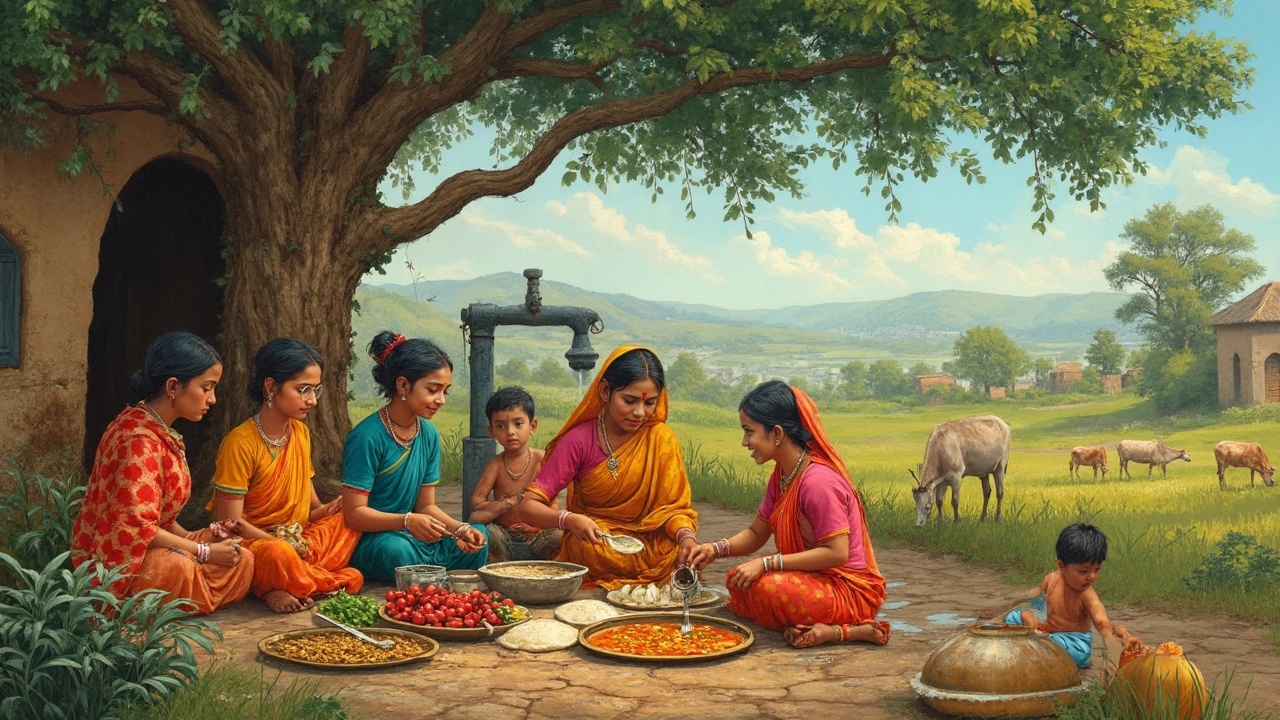When you think of a country that's synonymous with vegetarianism, India often comes to mind right away. But why is that? It's not only a matter of culture; it's deeply rooted in religious beliefs and age-old traditions. In India, the idea of a meat-free diet isn't new or trendy—it's been a way of life for centuries.
Vegetarianism in India is intertwined with religions like Jainism and Hinduism, which encourage non-violence and compassion towards all living beings. This cultural ethos means that vegetarian options aren't just available—they're a fundamental part of daily meals.
Imagine walking down a bustling market street in India, where the aroma of spices fills the air. Everywhere you turn, there's a new vegetarian dish to try, each promising an explosion of flavors. From creamy paneer curries to spicy lentil soups, there's something to delight every palate.
Curious how Indian cuisine maintains such vibrant flavors without meat? The answer lies in the spices—ginger, garlic, turmeric, coriander, and more—all working in harmony to create dishes that are anything but bland. Want to dive into the world of Indian vegetarian cuisine? Start simple, maybe with a comforting bowl of dal or a crunchy samosa. It's not just about eating; it's an experience.
- India's Vegetarian Legacy
- Popular Indian Vegetarian Dishes
- Tips for Enjoying Indian Vegetarian Foods
- The Future of Vegetarianism Globally
India's Vegetarian Legacy
India's association with a vegetarian lifestyle is the stuff of legends, deeply rooted in its diverse cultural and religious heritage. The love affair with a plant-based diet is far from a fad—it's a tradition that boasts thousands of years. But what makes India stand out when it comes to vegetarianism?
The Cultural and Religious Roots
The commitment to a vegetarian diet can largely be attributed to religious principles, primarily from Hinduism, Jainism, and Buddhism. These beliefs promote non-violence and compassion, extending that kindness to animals. Among Jains, for instance, consuming underground vegetables is often avoided to prevent harm to small organisms.
Regional Variations
India isn't just one big homogenous zone of vegetarianism—it's a patchwork quilt of regions, each with its own take on meatless dishes. South Indian states like Tamil Nadu and Kerala offer things like dosa and sambar, whereas in North India—think Punjab—paneer and legumes are staples. Each region has its unique way of presenting vegetarian cuisine, ensuring a never-ending supply of tasty options.
Statistics That Matter
| State | Percentage of Vegetarians |
|---|---|
| Rajasthan | 74% |
| Haryana | 70% |
| Punjab | 65% |
These stats show just how prevalent vegetarianism is in certain Indian states. It's not just individual choice; it's often community-driven, shaping meals and celebrations.
Economical and Environmental Impact
Did you know that a vegetarian lifestyle tends to be more economical and environmentally friendly? Many staple ingredients like lentils, beans, and rice, are not only affordable but also have a lower carbon footprint. It’s a sustainable way to not just nourish the family, but to help the planet as well.
So, if you're ever in India or just exploring vegetarian options from afar, delve into its rich, varied, and deeply meaningful vegetarian legacy. It's more than food; it's a lifestyle drawn from history itself.
Popular Indian Vegetarian Dishes
India is a treasure trove of vegetarian dishes, each region boasting its unique flavors and styles. It's easy to get lost in the variety, but here are some classics you shouldn't miss.
Paneer Tikka
This beloved appetizer features chunks of paneer, or Indian cottage cheese, marinated in a spicy yogurt mix and grilled to perfection. It's like the vegetarian answer to BBQ but loaded with flavors like cumin and coriander. You'll often find it served with a side of mint chutney.
Masoor Dal
A staple in Indian households, this simple lentil soup packs a punch. Rich in protein, masoor dal is cooked with spices like turmeric, garlic, and ginger, making it not just nutritious but delicious too. Serve it alongside rice or with naan for a comforting meal.
Aloo Gobi
Who knew potatoes and cauliflower could taste this good? Aloo Gobi is a dry curry that beautifully balances these humble veggies with spices like mustard seeds and turmeric. It's a popular dish that even non-vegetarians enjoy.
Chole Bhature
This is a match made in heaven. Chole, a spicy chickpea curry, pairs perfectly with Bhature, a type of fluffy fried bread. It's a hearty meal often found in North Indian cuisine and is best savored hot, straight out of the kitchen.
Dosa
From the southern part of India comes Dosa, a crispy crepe made from fermented rice and lentil batter. It's often filled with a spicy potato mix, and served with coconut chutney and tangy sambar. It's a breakfast staple but let's be honest, it tastes great any time of the day!
Getting your hands on these vegetarian delights isn't tough. Whether at a local eatery or cooked at home, these dishes promise not just to fill your belly but to bring a taste of India right to your table.

Tips for Enjoying Indian Vegetarian Foods
So, you're ready to dive into the flavorful world of Indian vegetarian cuisine. Awesome choice! Indian meals offer a treasure trove of tastes, textures, and aromas, and you don't even need meat to make them exciting. Check out these tips to enhance your experience:
Explore Regional Variations
Did you know that different regions in India specialize in unique vegetarian dishes? For instance, South Indian classics like idli and dosa are way different from North Indian delights such as chole bhature or paneer-tikka. Each region's specialties bring something new to the table, so mix it up and try a bit from everywhere.
Mastering the Spice Game
Don’t shy away from spices. They're the backbone of Indian cooking and what give dishes their signature flavors. If you're sensitive to heat, start small. Use spices like cumin, turmeric, and coriander to add depth without overwhelming heat. Remember, it's not just about making things spicy, but flavorful.
Keep it Fresh and Vibrant
A lot of Indian vegetarian dishes rely on fresh ingredients such as vegetables, herbs, and legumes. Go for seasonal produce, and you'll notice a difference. Whether it's a homemade meal or at a restaurant, fresh ingredients make the dish pop.
Find the Right Balance
Indian meals are all about balance—between flavors, textures, and even nutrients. Try to include a grain, protein, vegetable, and dairy in your meal. A typical Indian thali might show this balance in action, presenting a little bit of everything on a single plate.
Learn Basic Vegetarian Recipes
- Dal Tadka: A simple yet delicious lentil soup that pairs perfectly with rice.
- Palak Paneer: A spinach-based dish with chunks of cheese—filling and nutritious.
- Aloo Gobi: Potatoes and cauliflower spiced to perfection. It's a hearty and satisfying choice.
Don’t hesitate to experiment with these at home. You’ll not only boost your cooking skills but get comfortable with vegetarian dishes. You’ll find yourself loving the process as much as the result!
Get Social with the Cuisine
Indian eating often revolves around family or social settings. Sharing meals leads to discovering new dishes and flavors. Next time you're at an Indian spot or home meal, enjoy it social-style. You’d be amazed how food can spark conversations and connections.
Ready to hit the kitchen or restaurant? Armed with these tips, your journey into vegetarian India is bound to be deliciously rewarding!
The Future of Vegetarianism Globally
So, where is vegetarianism headed on the world stage? With a growing awareness of health issues and environmental concerns, more people globally are ditching meat or cutting it down, giving vegetarianism a bright outlook.
Health Drives Change
Doctors and dieticians are increasingly highlighting the health benefits of a plant-based diet. Reduced risks of heart disease, diabetes, and certain cancers are all associated with vegetarianism. This info is encouraging a shift, especially in places that traditionally leaned heavily on meat.
Environmental Impact
It's no secret that meat production has a massive carbon footprint. As the world faces climate change, people are looking for ways to minimize their impact—and going vegetarian is a pretty effective step. Cutting down on meat means using less water and land and reducing greenhouse gas emissions.
Technology and Food Innovation
Ever heard of lab-grown meat or plant-based substitutes that taste just like the real thing? Technology is expanding food choices for those transitioning to vegetarian diets. Companies are creating products that cater to people's love for traditional meaty textures and flavors, making it easier for them to make the switch.
Shifting Cultural Perspectives
As diverse cuisines become more accessible globally, traditional vegetarian dishes like those from Indian cuisine are introduced to new audiences. These exchanges are normalizing vegetarianism as a feasible and flavorful option.
| Year | Percentage of Vegetarians Globally |
|---|---|
| 2020 | 8% |
| 2025 | Projected 12% |
The global market for vegetarian products is projected to grow significantly, reflecting changing consumer priorities. As more restaurants and food producers jump on board, finding delicious vegetarian dishes becomes the norm rather than the exception.
